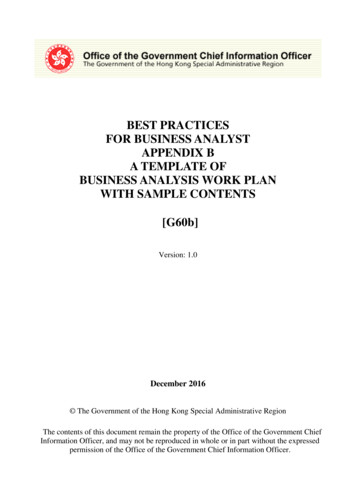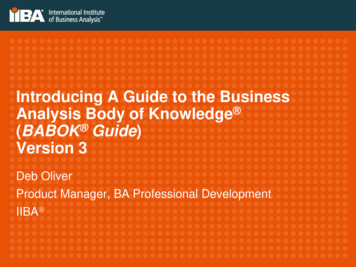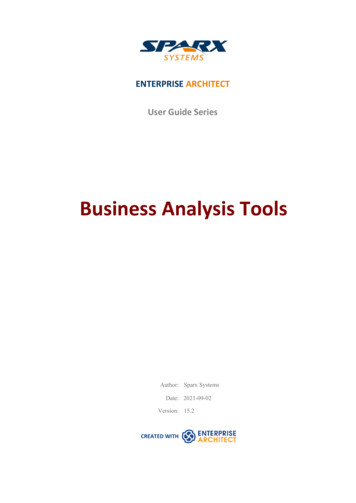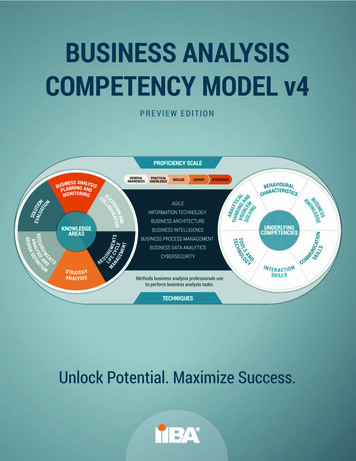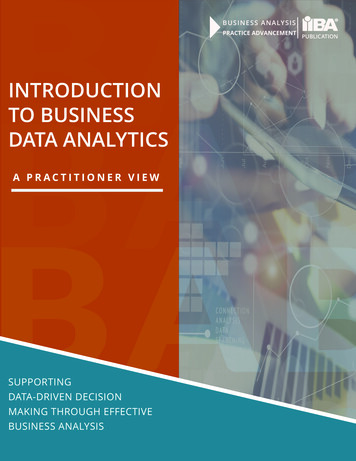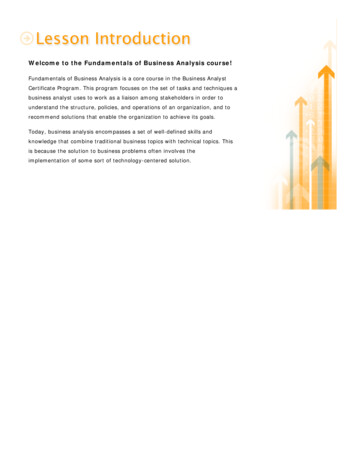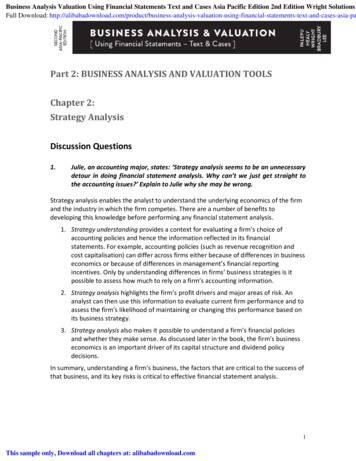
Transcription
Business Analysis Valuation Using Financial Statements Text and Cases Asia Pacific Edition 2nd Edition Wright SolutionsFull Download: ases-asia-paPart 2: BUSINESS ANALYSIS AND VALUATION TOOLSChapter 2:Strategy AnalysisDiscussion Questions1.Julie, an accounting major, states: ‘Strategy analysis seems to be an unnecessarydetour in doing financial statement analysis. Why can’t we just get straight tothe accounting issues?’ Explain to Julie why she may be wrong.Strategy analysis enables the analyst to understand the underlying economics of the firmand the industry in which the firm competes. There are a number of benefits todeveloping this knowledge before performing any financial statement analysis.1. Strategy understanding provides a context for evaluating a firm’s choice ofaccounting policies and hence the information reflected in its financialstatements. For example, accounting policies (such as revenue recognition andcost capitalisation) can differ across firms either because of differences in businesseconomics or because of differences in management’s financial reportingincentives. Only by understanding differences in firms’ business strategies is itpossible to assess how much to rely on a firm’s accounting information.2. Strategy analysis highlights the firm’s profit drivers and major areas of risk. Ananalyst can then use this information to evaluate current firm performance and toassess the firm’s likelihood of maintaining or changing this performance based onits business strategy.3. Strategy analysis also makes it possible to understand a firm’s financial policiesand whether they make sense. As discussed later in the book, the firm’s businesseconomics is an important driver of its capital structure and dividend policydecisions.In summary, understanding a firm’s business, the factors that are critical to the success ofthat business, and its key risks is critical to effective financial statement analysis.1This sample only, Download all chapters at: alibabadownload.com
22.3.Palepu 2e Solutions ManualWhat are the critical drivers of industry profitability?-Rivalry Among Existing Firms: The greater the degree of competition amongfirms in an industry, the lower average profitability is likely to be. The factorsthat influence existing firm rivalry are industry growth rate, concentration andbalance of competitors, degree of differentiation and switching costs,scale/learning economies and the ratio of fixed to variable costs, and excesscapacity and exit barriers.-Threat of New Entrants: The threat of new entry can force firms to set pricesto keep industry profits low. The threat of new entry can be mitigated byeconomies of scale, first mover advantages to incumbents, greater access tochannels of distribution and existing customer relationships, and legal barriersto entry.-Threat of Substitute Products: The threat of substitute products can forcefirms to set lower prices, reducing industry profitability. The importance ofsubstitutes will depend on the price sensitivity of buyers and the degree ofsubstitutability among the products.-Bargaining Power of Buyers: The greater the bargaining power of buyers, thelower the industry’s profitability. Bargaining power of buyers will bedetermined by the buyers’ price sensitivity and their importance to theindividual firm. As the volume of purchases of a single buyer increases, itsbargaining power with the supplier increases.-Bargaining Power of Suppliers: The greater the bargaining power of suppliers,the lower the industry’s profitability. Suppliers’ bargaining ability increases asthe number of suppliers declines when there are few substitutes available.What sources of information would you use to conduct a strategy analysis on anorganization in Australia or New Zealand?Strategy analysis involves industry analysis, competitive strategy analysis and corporatestrategy analysis.One secondary source of information for industry analysis, including competitive andcorporate strategy analyses, is a commercial database that may be available at yourlibrary, such as IBISWorld, OneSource and Finanalysis. These are secondary sourcesbecause their analysis uses primary sources of information, and by using them you arerelying on the accuracy of both their research and their interpretation.Copyright 2015 Cengage Learning Australia Pty Limited
Ch 02: Strategy Analysis3Primary sources include industry association webpage and publications, and governmentstatistical collections, such as are available from the Australian Bureau of Statistics inAustralia. Information on the industry may also be found on the company’s website, onthe websites of its competitors, in newspapers, and in academic and practitioner journals.It is also a useful starting point to examine the state of the economy or economies inwhich the company is operating. For a company operating in Australia or New Zealand,apart from the country of operation, that might also include countries from which rawmaterials are sourced or in which sales (as exports) are made. Sources of information onthe economy of a country can be found on government websites, such as the ReserveBank of Australia website, and the Australian Bureau of Statistics website in Australia.4.One of the challenges of strategy analysis for an organisation in a smallereconomy is finding sufficient competitors in its same industry. Apart from beingin the same industry, offering the same products or services, what are othercommon factors between organisations that permit you to undertake aneffective strategy analysis? What factors are not sufficient to permit an effectivecomparison? (For example, meeting the same customer needs with a differentproduct or service may be sufficient, whereas being located in the same regionmay not.)It is not possible to identify all of the common factors that could be appropriate forchoosing a competitor for the wide range of companies operating in Australia and NewZealand. And in some unusual cases, it is conceivable that the factors that are identifiedbelow as insufficient may in fact be suitable. The following answer is therefore indicative,and can be considered as a useful base for a classroom discussion:Effective common factors:-Major customers, such aso Governmento Manufacturing firmo Socio-economic group-Similar economic drivers, such aso Demand for health products or serviceso Demand for security products or serviceso Demand for entertainment products or services-Firm characteristics, such aso Similar sizeo Similar level of diversificationo Similar capital structureo Similar ageCopyright 2015 Cengage Learning Australia Pty Limited
4Palepu 2e Solutions Manualo Similar regulations applyo Similar business model (e.g., not-for-profit)o Similar reliance on weather or seasonNot effective common factors:5.-Similar employees-Similar suppliers-Loss-making status-Exposure to foreign exchange-RegionIn undertaking a strategy analysis, what are the difficulties of comparingorganisations that dinner with respect to:a. country of operationb. products or services that meet the same customer needsc. more than 30% of revenues coming from different sourcesd. competitive advantagee. industry classificationf. corporate strategya)b)Country of operation-Different legal and regulatory requirements.-Different cultural and social expectations and tastes.-Currency is not a difficulty, as financial analysis uses ratios which abstract fromthe currency unit.Products or services that meet the same customer needs-Not all customers may use the product or service to meet the same need. Forexample, although train and air transport serve the same need for customerstravelling long distances over land, and sea and air transport serve the sameneed for customers travelling long distances over sea, they are not substitutesfor customers who need to take a car with them.-There may be a future change in customer tastes that renders one product orservice less popular.Copyright 2015 Cengage Learning Australia Pty Limited
Ch 02: Strategy Analysis-c)d)e)f)There may be a future change in costs due to a change in technology or otherreason, which affects the product or service pricing and diminishes theirsubstitutability.More than 30% of revenues coming from a different source-While there is always a chance that two companies will change to be lesssimilar in the future, if one is already more diversified, then there is morechance of this happening, as the company may expand the operations of thisone division (revenue source).-If one company is more diversified, then the two companies may havedifferent risks, depending on the combinations of industries in which theyoperate.Competitive advantage-The two companies may differ in ways that affect the comparability of theirperformance; for example, different profitability or different assets.-The two companies may have different strategies.-The two companies may respond differently to a change in the operatingenvironment.Industry classification-It will be hard to find common information on their operating environment.-Depending on the reasons for their different industry classifications, they mayhave different business models and they may face different cost pressures.Corporate strategy-The two companies may differ in which aspects of their operations areoutsourced and which are retained in-house.-The two companies may therefore differ in ways that affect the comparabilityof their performance; for example, different complexity, different profitabilityor different assets.-They will face different cost pressures.-The two companies may respond differently to a change in the operatingenvironment.Copyright 2015 Cengage Learning Australia Pty Limited5
66Palepu 2e Solutions ManualOne of the fastest growing industries in the last 20 years is the memory chipindustry, which supplies memory chips for personal computers and otherelectronic devices. Yet the average profitability for this industry has been verylow. Using the industry analysis framework, list all the potential factors thatmight explain this apparent contradiction.-Concentration and Balance of Competitors: The concentration of the memorychip market is relatively low. There are many players that compete on a globalbasis, none of which has a dominant share of the market. Due to this highdegree of fragmentation, price wars are frequent as individual firms lowerprices to gain market share.-Degree of Differentiation and Switching Costs: In general, memory chips are acommodity product characterised by little product differentiation. While someproduct differentiation occurs as chip makers squeeze more memory on asingle chip or design specific memory chips to meet manufacturers’ specificpower and/or size requirements, these differences are typically short-livedand have not significantly reduced the level of competition within the industry.Furthermore, because memory chips are typically interchangeable, switchingcosts for users of memory chips (computer assemblers and computer owners)encouraging buyers to look for the lowest price for memory chips.-Scale/Learning Economies and the Ratio of Fixed to Variable Costs: Scale andlearning economies are both important to the memory chip market. Memorychip production requires significant investment in ‘clean’ productionenvironments. Consequently, it is less expensive to build larger manufacturingfacilities than to build additional ones to satisfy additional demand. Moreover,the yield of acceptable chips goes up as employees learn the intricacies of theextremely complicated and sensitive manufacturing process. Finally, whileinvestments in memory chip manufacturing plants are typically very high, thevariable costs of materials and labour are relatively low, providing an incentivefor manufacturers to reduce prices to fully utilise their plant’s capacity.-Excess Capacity: Historically, memory chip plants tend to be built in waves, sothat several plants will open at about the same time. Consequently, theindustry is characterised by periods of significant excess capacity wheremanufacturers will cut prices to use their productive capacity (see above).-Threat of Substitute Products: There are several alternatives to memory chipsincluding other information storage media (e.g., hard drives and disk drives)and memory management software that ‘creates’ additional memory throughmore efficient use of computer system resources.Copyright 2015 Cengage Learning Australia Pty Limited
Ch 02: Strategy Analysis-7Price Sensitivity: There are two main groups of buyers: computermanufacturers and computer owners. Faced with an undifferentiated productand low switching costs, buyers are very price sensitive.All the above factors cause returns for memory chip manufacturers to be relatively low.7.Rate the leisure and hospitality industry and the mining industry as high,medium, or low on the following dimensions of industry structure.-Rivalry-Threat of new entrants-Threat of substitute products-Bargaining power of buyers-Bargaining power of suppliersMining firms historically have had relatively high rates of return, whereas hospitality andleisure firms have had relatively low returns. The following analysis reveals why.RivalryHospitality and Leisure IndustryMining IndustryHighLowFirms compete fiercely for marketshare. The affluence of the economyhas increased access to this market formany consumers, encouraging a rapidincrease in the number of firms.Firms specialise in mining in aparticular geographic area orareas, limiting rivalry. Demand andprices have been strong, with theresult that the total market hasgrown and rivalry has not beenhigh.continues next pageCopyright 2015 Cengage Learning Australia Pty Limited
8Palepu 2e Solutions ManualThreat ofNew EntrantsHighMediumEntry to this industry is often low cost,and it is not affected by muchregulation. There is little advantage toa first mover, giving new entrants anequal chance with more establishedproviders. Attempts have been madeto reward loyalty, as a disincentive tonew entrants.Entry into the lumber industryrequires access to mining leasesand capital.Threat ofSubstituteProductsHighLowThere are many substitute productsand services in this market.Exploration is protected by leases,giving mining companies amonopoly in that region.BargainingPower ofBuyersLowHighHistorically, consumers have had littlebuying power.Many buyers are very large,including international companiesand countries.BargainingPower ofSuppliersLowNot applicable.There are few suppliers, and most ofthem are not well organised.Supplies of timber for lumber arelimited. Owners of timberland cansell to any lumber mill.Copyright 2015 Cengage Learning Australia Pty Limited
Ch 02: Strategy Analysis89Joe argues: ‘Your analysis of the five forces that affect industry profitability isincomplete. For example, in the banking industry, I can think of at least threeother factors that are also important: namely government regulation,demographic trends and cultural factors.’ His classmate Jun disagrees and says:‘These three factors are important only to the extent that they influence one ofthe five forces.’ Explain how, if at all, the three factors discussed by Joe affect thefive forces in the banking industry.Government regulation, demographic trends and cultural factors will each impact theanalysis of the banking industry. While these may be important, they can each be recastusing the five forces framework to provide a deeper understanding of the industry. Thepower of the five forces framework is its ability to incorporate industry-specificcharacteristics into analysis for any industry. To see how government regulation,demographic trends, and cultural factors are important in the banking industry, we canapply the five forces framework as follows:-Rivalry Among Existing Firms: Government regulation has played a central role inpromoting, maintaining and limiting competition among banks. Banks are regulated atthe federal and state levels. In the past, these regulations restricted banks fromoperating across state lines or even within different regions of the same state, andfrom paying market rates on deposits. The government also regulates the riskiness ofa bank’s portfolio in an effort to prevent banks from competing for new customers bytaking on too many high-risk investments, loans or other financial instruments. Theseregulations have limited the degree of competition among banks. However, recentderegulation of the industry has allowed banks to expand into new geographic areasand to pay market rates on deposits, increasing the level of competition.-Threat of New Entrants: Government regulations at both the federal and state levelshave limited the entry of new players into the banking industry. New banks mustmeet the requirements set by regulators before they can begin operation. However,as noted above, deregulation of some aspects of banking has made it easier for outof-state banks to enter new markets. Further, it appears to be relatively easy for nonbanking companies to successfully set up financial services units (e.g., AT&T, GE andGeneral Motors). Finally, as consumers have become more comfortable withtechnology, ‘Internet banks’ have formed. These ‘banks’ provide the same services astraditional banks, but with a very different cost structure.-Threat of Substitute Products: The primary functions of banks are lending money andproviding a place to invest money. Thrifts, credit unions, brokerage houses, mortgagecompanies, and the financing arms of companies, such as GMAC, provide potentialsubstitutes for these functions. Government regulation of these entities variesdramatically, affecting how similar their products are to those of banks. In addition,with the expansion of superannuation and retirement savings accounts, consumersCopyright 2015 Cengage Learning Australia Pty Limited
10Palepu 2e Solutions Manualhave been become increasingly familiar with non-bank options for investing money.As another example, some brokerage houses provide money market accounts thatfunction as checking accounts. As a result, the threat of substitutes for bank serviceshas grown over time.-Bargaining Power of Buyers: Business and consumer buyers of credit have little directbargaining power over banks and financial institutions. The decline in relationshipbanking towards a transactions approach, where consumers seek the lowest-costlender for each new loan, probably also reduces the buying power of customers.-Bargaining Power of Suppliers: Depositors have historically had little bargainingpower.In summary, bank regulations have historically had a very important role in determiningbank profitability by restricting competition. However, recent deregulation in the industryas well as the emergence of non-bank substitutes has increased competition in theindustry.9.Coca-Cola and Pepsi are both very profitable soft drinks. Inputs for theseproducts include corn syrup, bottles/cans and soft drink syrup. Coca-Cola andPepsi produce the syrup themselves and purchase the other inputs. They thenenter into exclusive contracts with independent bottlers to produce theirproducts. Use the five forces framework and your knowledge of the soft drinkindustry to explain how Coca-Cola and Pepsi are able to retain most of theprofits in this industry.While consumers perceive an intensely competitive relationship between Coke and Pepsi,these major players in the soft drink industry have structured their businesses to retainmost of the profits in the industry by concentrating operations in its least competitivesegments. Coke and Pepsi have segmented the soft drink industry into two industries –production of soft drink syrup and manufacturing/distribution of the soft drinks at theretail level. Moreover, they have chosen to operate primarily in the production of softdrink syrup, while leaving the independent bottlers with the more competitive segmentof the industry.Coca-Cola and Pepsi compete primarily on brand image rather than on price. They selltheir syrup to independent bottlers who have exclusive contracts to distribute soft drinksand other company products within a specific geographic area. (While other syrupproducers exist, they are typically regional and have very small shares of the market.)Given the large number of competing forms of containers for soft drinks (glass bottles,plastic bottles, aluminium cans, etc.), it is difficult for bottlers to earn any more than anormal return on their investment. Consequently, Coke and Pepsi can write exclusivecontracts with bottlers prohibiting them from simultaneously bottling for a competitor. ItCopyright 2015 Cengage Learning Australia Pty Limited
Ch 02: Strategy Analysis11is also difficult for independent bottlers to switch from Coke to Pepsi products, sincethere is likely to be an existing Pepsi bottler in the same geographic area. Consequently,independent bottlers have little bargaining power and Coke and Pepsi are able to chargethem relatively high prices for syrup.The threat of new entrants at the syrup level is restricted by limited access to adequatedistribution channels and by the valuable brand names that have been created by bothCoke and Pepsi. While soda syrup is relatively inexpensive and easy to make, a new syrupproducer would have difficulty finding a distributor that could get its products to retailstores and placed in desirable shelf space. The high levels of advertising by Coke andPepsi have created highly valued, universally recognised brands, which would be difficultfor a potential competitor to replicate.The main ingredients of syrup are sugar and flavouring, and the markets for these inputsare generally competitive. As a result, Coke and Pepsi exert considerable influence overtheir suppliers. For example, in the 1980s when corn syrup became a less-expensivesweetener than cane sugar, Coke and Pepsi switched to corn syrup. Thus, Coke and Pepsiare able to retain profits rather than pay them out to their suppliers.The production and distribution of soft drinks at the retail level is likely to be lessprofitable than is syrup production for several reasons. First, despite tremendousamounts of advertising designed to create differentiated products, many people viewsodas as being relatively similar and switching costs for consumers are very low, whichmakes it difficult to price one soft drink significantly higher than another. Secondly, thereare a great number of substitutes for soft drinks, such as water, milk, juice, athletic drinks,etc., which consumers could switch to if the price of soda were to increase. Thirdly,because of low switching costs, consumers can be price sensitive and also exerciserelative bargaining power over independent bottlers. Finally, as discussed before, thestructure of the relationship between Coke and Pepsi and the independent bottlers givesCoke and Pepsi greater bargaining power over the bottlers, further limiting the ability ofindependent bottlers to keep a larger share of their profits.10.In the 1980s and 1990s, many airline companies started frequent flier programsas a way to differentiate themselves in response to excess capacity in theindustry. Many industry analysts, however, believe that this move had onlymixed success. Use the competitive advantage concepts to explain why.Initially, frequent flier programs had only limited success in creating differentiationamong airlines. Airlines tried to bundle frequent flier mileage programs with regularairline transportation to increase customer loyalty and to create a differentiated product.Furthermore, the airlines anticipated that the programs would fill seats that wouldotherwise have been empty and would, so they believed, have had a low marginal cost.Copyright 2015 Cengage Learning Australia Pty Limited
12Palepu 2e Solutions ManualHowever, because the costs of implementing a program were low, there were very fewbarriers to other airlines starting their own frequent flier programs. Before long, everyairline had a frequent flier program with roughly the same requirements for earning freeair travel. Simply having a frequent flier program no longer differentiated airlines.More recently, airlines have had some success in differentiating frequent flier programsby creating additional ways to earn frequent flier mileage and increasing the number ofdestinations covered. Airlines have developed ‘tie-ins’ with credit card companies, carrental companies, hotels, etc. to allow members of a particular frequent flier programmore ways to earn frequent flier mileage. They have also reached agreements withforeign airlines so that frequent flier mileage can be redeemed for travel to locations notserved by the carrier. Finally, the programs have provided additional services for theirbest customers, including special lines for check-in and better flight upgradeopportunities. As a result of these efforts, airline programs have been somewhatsuccessful in increasing customer loyalty.11.What are the ways by which an organisation can create barriers to entry todeter competition in its business? What factors determine whether thesebarriers are likely to be enduring?Barriers to entry allow a firm to earn profits while at the same time preventing otherfirms from entering the market. The primary sources of barriers to entry includeeconomies of scale, absolute costs advantages, product differentiation advantages andgovernment restrictions on entry of competitors. Firms can create these barriers througha variety of means.1. A firm can engineer and design its products, processes and services to createeconomies of scale. Because of economies of scale, larger plants can producegoods at a lower cost than smaller plants. Hence, a firm considering entering theexisting firm’s market must be able to take advantage of the same scaleeconomies or be forced to charge a higher price for its products and services.2. Cost leaders have absolute cost advantages over rivals. Through the developmentof superior production techniques, investment in research and development,accumulation of greater operating experience or special access to raw materials,or exclusive contracts with distributors or suppliers, cost leaders operate at alower cost than any potential new entrants to the market.3. A firm can engineer and design its products, processes and services to createeconomies of scale. Because of economies of scale, larger plants can producegoods at a lower cost than smaller plants. Hence, a firm considering entering theexisting firm’s market must be able to take advantage of the same scaleeconomies or be forced to charge a higher price for its products and services.Copyright 2015 Cengage Learning Australia Pty Limited
Ch 02: Strategy Analysis134. Differentiation of the firm’s products and services may also help create barriers toentry for other firms. Firms often spend considerable resources to differentiatetheir products or services. Soft drink makers, for example, invest in advertisingdesigned to differentiate their products from other products in the market. Othercompetitors that would like to enter the market will be forced to make similarinvestments in any new products.5. Firms often try to persuade governments to impose entry restrictions throughpatents, regulations and licenses. AT&T fought with the government for manyyears to prevent other providers of a long distance telephone service fromentering the market. Similarly, the local Bell operating companies have lobbiedthe federal government to write laws to make it difficult for other firms to providelocal phone service.Several factors influence how long specific barriers to entry are effective at preventingthe entry of competitors into an industry.-Economies of scale depend on the size and growth of the market. If a market isgrowing quickly, a competitor could build a larger plant capable of producing at a costlower than the incumbent. If a market is flat, there may not be enough demand tosupport additional production at the efficient scale, which forces new entrants tohave higher costs.-Absolute cost advantages depend on competitors’ difficulty in designing betterprocesses. Some processes receive legal protection from patents. Entrants musteither wait for the patent to expire or bear the expense of trying to invest around thepatent. Similarly, differentiation advantages last only so long as a firm continues toinvest in differentiation and it is difficult for other firms to replicate the samedifferentiated product or service.-Incumbent firms and potential entrants can both lobby the government. If potentialentrants launch intensive lobbying and public interest campaigns, laws, regulationsand rules can change to ease entry into a once-protected industry. Several recentexamples in the U.S. are deregulation of the airline, trucking, banking andtelecommunications industries.Copyright 2015 Cengage Learning Australia Pty Limited
1412.Palepu 2e Solutions ManualExplain why you agree or disagree with each of the following statements:a. It’s better to be a differentiator than a cost leader, since you can then chargepremium prices.b. It’s more profitable to be in a high technology than a low technology industry.c. The reason why industries with large investments have high barriers to entryis because it is costly to raise capital.a. Disagree: While it is true that differentiators can charge higher prices compared tocost leaders, both strategies can be equally profitable. Differentiation is expensive todevelop and maintain. It often requires significant company investment in researchand development, engineering, training and marketing. Consequently, it is moreexpensive for companies to provide goods and services under a differentiatedstrategy. Thus, profitability of a firm using the differentiated strategy depends onbeing able t
In summary, understanding a firm’s business, the factors that are critical to the success of that business, and its key risks is critical to effective financial statement analysis. Business Analysis Valuation Using Financial Statements Text and Cases

